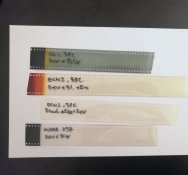grainyvision
Subscriber
[QUOTE
I'm hoping someone here has some kind of insight into this in PE's absence, but ECP film seems like a very obscure material and process. I've seen pretty much nothing in regards to attempts to cross processing it or even just generally using it in-camera.
Anyone have any ideas?
Hi,
I have done lots of experiments with the 2383 and 2393 film stocks.
To use the film in camera can be done, but the results are from from worth the effort. You need to use an unexposed processed piece of film as a filter on the camera lens, I used a piece of 65mm 500T to make a 52mm lens filter. Exposure times are very long even in full sun, expect to expose for 1 second or more. Obviously you will get a negative image on a clear film base which takes some tweaking in scanning.
ECN2 developer works well with processing the film, 3 mins at 38c for the dev, 30s stop, 1 min bleach and 40s Fix, all at 38c.No need to use the bleach at 27c, that's just an industry spec due to the aggressive bleach eating way at the tyres on the processing racks!.
Here is an example of a contact print using 70Y and 5M on a colour head, exposure was 1s at a distance of around 4 inches from enlarger lens to film surface.
View attachment 263995
Here is an example of in camera exposure using the film base as a filter.
View attachment 263996
I did not bother trying to make a contact print from the 2383 negative image to get a Pos because I would imagine further filtering would be needed using the enlarger filter pack.
Another possibility would be to process the in camera exposed film in a B&W reversal kit!. For exposure this would eliminate the need to filter the camera lens so you can expose at 3 iso. An experiment I may do in the summer when light levels are higher for these slow films.
From my experiments of contact printing from Kodak B&W films, like Plus-x onto the 2383, the images are sepia, likely due to the colour dyes in the 2383. Further experiments are needed as I used XTol and TMax fix in the test. Maybe using the ecn2 kit would produce a better B&W result.
I hope this helps you in some way and I'm open to any questions you may have as myself and a few others are doing ongoing experiments with this film stock.
As for the ecp developer, I have some that was made special order by Bellini photo. I found it impossible to balance the filter pack to get the colours correct, maybe because I'm not fully following the ECP processing steps, with things like the pre bleach!. To me, I found a way to get slide from my ecn negatives using the ecn kit which is available from Bellini at a reasonable cost and the workflow is simple and fast.
Mick
.[/QUOTE]
I was able to get a high contrast maskless negative in C-41, but all attempts at reversal processing have been a complete failure, end result is blank film. I've not tried using B/W reversal, but since I have the chemicals to do that now I might try it. I figured such a bleach though would be so aggressive to destroy or damage the dyes, and I'm mainly interested in getting it to behave as a positive color film rather than positive B/W film. I doubt it has enough silver to build good B/W density













